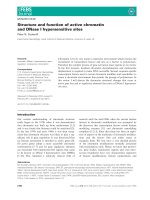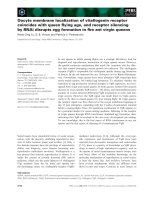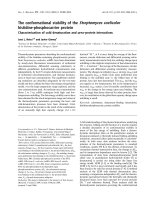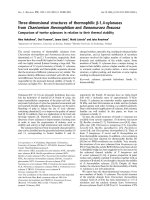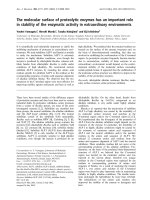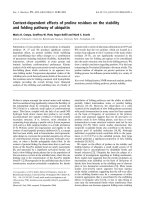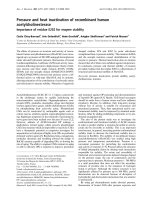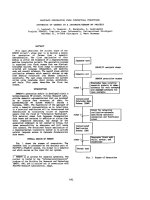Báo cáo khoa hoc:" Formation and stability of oil-in-water nanoemulsions containing rice bran oil: in vitro and in vivo assessments" pdf
Bạn đang xem bản rút gọn của tài liệu. Xem và tải ngay bản đầy đủ của tài liệu tại đây (599.16 KB, 9 trang )
RESEARCH Open Access
Formation and stability of oil-in-water
nanoemulsions containing rice bran oil:
in vitro and in vivo assessments
Daniela S Bernardi
1*
, Tatiana A Pereira
1
, Naira R Maciel
1
, Josiane Bortoloto
1,2
, Gisely S Viera
1
, Gustavo C Oliveira
1
and Pedro A Rocha-Filho
1
Abstract
Background: Nanoemulsions have practical application in a multitude of commercial areas, such as the chemical,
pharmaceutical and cosmetic industries. Cosmetic industries use rice bran oil in sunscreen formulations, anti ageing
products and in treatments for skin diseases. The aim of this study was to create rice bran oil nanoemulsions using
low energy emulsification methods and to evaluate their physical stability, irritation potential and moisturising
activity on volunteers with normal and diseased skin types.
Results: The nanoemulsion developed by this phase diagram method was composed of 10% rice bran oil, 10%
surfactants sorbitan oleate/PEG-30 castor oil, 0.05% antioxidant and 0.50% preservatives formulated in distilled
water. The nanoemulsion was stable over the time course of this study. In vitro assays showed that this formulation
has a low irritation potential, and when applied to human skin during in vivo studies, the nanoemulsion improved
the skin’s moisture and maintained normal skin pH values.
Conclusion: The results of irritation potential studies and in vivo assessments indicate that this nanoemulsion has
potential to be a useful tool to treat skin diseases, such as atopic dermatitis and psoriasis.
Background
Nanoemulsions are obtained when the size of an emulsion
globule reaches approximately 20-500 nm. The small dro-
plet size can resist the physical destabilisation caused by
gravitational separation, flocculation and/or coalescence. It
also avoids the cre aming process because the droplet’s
Brownian motion is enough to overcome the gravitational
separation force [1,2]. The size and p olydispersity of
nanoemulsions can affect properties such as particle stabi-
lity, rheology, appearance, colour, texture and shelf life [3].
In nanoemulsions, the most frequent instability phenom-
enon is Ostwald ripening [4,5], which can be calculated
according to the Lifshitz-Slezov and Wagner theory
(LSW) using the following equation [6,7]:
ω =
dr
3
n
dt
= k
Dc
∞
γ M
ρ
2
RT
(1)
Where ω is defined as the rate of change of the cube of
the number average radius, D is the diffusion coefficient
of the dispersed oil phase in the aqueous phase, g is the
interfacial tension between the two p hases, c
∞
is the bulk
solubility of the oil in the water and r is the oil density. k
is a constant that has the value of 8/9 in the LSW.
Nanoemulsions are well characterised and are a promis-
ing drug delivery system with practical applications for
pharmaceutical, cosmetic and chemical industry applica-
tions. They have been used in intravenous, oral and ocular
drug administrations and have reduced drug side effect s
and improved the pharmacological effects o f the drugs
given [8-10,4]. Nanoemulsions are primarily produced
either by high-energy emulsification (e.g., high-pressure
homogenisation) or by low-energy emulsification (using
physicochemical properties of the components) [11]. This
work focuses on the latter method for nanoemulsion
synthesis.
* Correspondence:
1
Departamento de Ciências Farmacêuticas, Faculdade de Ciências
Farmacêuticas de Ribeirão Preto, Universidade de São Paulo, Ribeirão Preto,
São Paulo, Brazil
Full list of author information is available at the end of the article
Bernardi et al. Journal of Nanobiotechnology 2011, 9:44
/>© 2011 Ber nardi et al; licensee BioMed Central Ltd. This is a n Open Access article distributed under the terms of the Cr eative Commons
Attribution License ( which permits unrestricted use, distribution, and reproduction in
any medium, provided the original work is properly cited.
Rice (Oryza sativa) bran oil has unsaponifiable fractions
that contain high levels of antioxidant-rich components,
such as tocopherols/tocotrienols and gamma-oryzanol ,
which could be useful for topical formulations [12]. The
cosmetics industry has used rice bran oil in sunscreen for-
mulations [13], in topical aging prevention prod ucts [14 ]
and in treatments for skin diseases [15].
When skin is affected by diseases such as atopic derma-
titis and psoriasis, it exhibits a compromised skin barrier
function that causes increased transepidermal water loss
[16-18]. Moisturisers can h elp improve t he skin’ sfunc-
tion by relie ving the cutaneous manifestations o f these
diseases [18-20]. Measuring the stratum corneum (SC)
hydration degree gives important information about the
biophysical properties and the function of the skin [21].
In vitro studies, such as the HET-CAM (Hen’ sEgg
Test on the Chorioallantoic Membrane), are used to
evaluate cosmetics products by immediately show ing
whether or not a solid or liquid s ubstance irritates the
hen’s egg chorioallantoic membrane [22].
The aim of this s tudy was to obtain nanoemulsions of
rice bran oil and to evaluate their physical stability, irri-
tating potential and in vivo moisturising activity.
Materials and methods
Materials
Sorbitan oleate (HL B 4.3) and rice bran oil were kindly
provided from Lipo do Brasil (Brazil). PEG-30 castor oil
(HLB 11.7) was donated by Oxiteno (Brazil). The preserva-
tive DMDM Hydantoin (and) Iodopropynyl Butylcarba-
mate (Glydant
®
plus) was obtained from Chemyunion
(Brazil), and the antioxidant Butyl Hydroxy Toluene
(BHT) was purchased from Synth (Brazil).
Preparation of nanoemulsion
The following surfactant mixtures were evaluated to find a
stable nanoemulsion formulation: polysorbate 80/sorbitan
oleate, polysorbate 60/sorbitan oleate, ceteareth-20 OE/
ceteth-2, PEG-15 castor oil/sorbitan oleate, PEG-30 castor
oil/sorbitan oleate and PEG-40 castor oil/sorbitan oleate.
The PEG-30 castor oil/sorbitan oleate (HLB
resulting
=8.0)
was t he only surfactant combination that resulted in a
stable formulation and therefore was chosen for further
study.
The phase diagram method was used w ith different
concentration of constituents to result in 42 different
emulsion formulations. All emulsions were prepared
according t he Emulsion Phase Inversion (EPI) method,
where the water and oil phases were heated separately
at 75°C, the water phase was added into the oil phase
(rice bran oil and surfactants) while stirring at 600 rpm
(Fisatom, 713-Dmodel, Brazil), and the mixture was
then cooled to 25°C while stirring.
Determination of nanoemulsion droplet size
The mean droplet size and polydispersity index of t he
nanoemulsions were determined by dynamic light scat-
tering (DLS) (Zetasizer, modelo ZS, Malvern Instru-
ments, UK). Measurements were performed at 25°C
using a scattering angle of 90°. Samples were considered
polydisperse when the polydispersity index was higher
than 0.2 [23].
Stability study
The preliminary stability of the nanoemulsion prepara-
tion was evaluated at 24 ho urs by centrifuge and thermal
stress analyses. Stability was assessed by macroscopic
emu lsion observation and droplet size anal ysis. The pur-
pose of these tests was to select a stable, low-surfactant
formulation with a nanoemulsion-size droplet and stable
physicochemical properties. The selected nanoemulsion
was prepared in triplicate, and the samples were stored at
25 ± 2°C, 40 ± 2°C and 5 ± 2°C. Tests were performed at
24 hours, 7, 15, 30, 60 and 90 days after preparation. The
analysis measurements were droplet size, pH value and
electrical conductivity.
Physical-chemical analyses
To perform the thermal stress test, nanoemulsions were
heated in an ultra bath thermostat (Nova Técnica, Brazil)
at temperatures ranging from 40 to 80°C. The temperature
was increased by 5°C every 30 minutes. The nanoemul-
sions were centrifuged (Fanem 206-R, Brazil) at 1000,
2500 and 3500 rpm (70, 440 and 863 G, respectively) for
15 minutes in each rotation to accelerate possible instabil-
ity phenomena. A pH meter (PM608 model - Analion,
Brazil) was used to measure the pH of the nanoemulsions
at 25 ± 2°C. The electrical conductivity was evaluated at
25 ± 2°C by a portable conductivity meter (mCA-150
model, Tecnopon, Brazil).
Irritant test in an organotypic model - HET-CAM (Hen’s
Egg Test on the Chorioallantoic Membrane)
TheHET-CAMtestisroutinelyusedtoevaluatethe
potential eye irritation of raw materials but can in some
cases be used to evaluate skin irritation, e.g. in the case
of surfactants. Irritation causes alterations in the vascu-
lar system of the HET-CAM that result in membrane
discoloration, haemorrhaging and increased perfusion.
The method used in this manuscript is a modification of
the method described by Luepke [24] and adapted by
Mehling [25] that allows the immediate evaluation of
irritation by solid or liquid substances in the hen’ segg
chorioallantoic membrane. Each substance was tested
on three fertilised eggs that were incubated for 9 days
prior to testing. The CAM ( Chorioallantoic Membrane)
was exposed to 300 μL of one of the following
Bernardi et al. Journal of Nanobiotechnology 2011, 9:44
/>Page 2 of 9
substances: (1) nanoemulsion (pH 6.54), (2) surfactant
solution blend (5% sorbitan oleate, 5% PEG-30 castor oil
and 90% water (pH 6.32), (3) Sodium lauryl sulphate
(SLS) 10% w/w (posit ive control, pH 6.05) and (4) saline
solution (negative control, pH 6.0). The CAM was
rinsed with physiological saline solution after 30 seconds
of exposure to each substance, and the intensity of the
reactions (hyperaemia, haemorrhage and coagulation)
was semi-quantitatively assessed on a scale of 0.5, 2 and
5 minutes after treatment ; longer observation times give
no additional important information. The numerical
time-dependent scores for hyperaemia, haemorrhage
and coagulation are summed to give a single numerical
value indicating the irritation potential of the test sub-
stance on a scale with a maximum value of 21. The
mean value of f our tests makes possible an assessment
by a classification scheme analogous to the Draize cate-
gories (Table 1).
In vivo assessment
Approval to conducted the in vivo studies was obtained
from the Ethics Committee of Faculdade de Ciências
Farmacêuticas de Ribeirão Preto, Ribeirão Preto, São
Paulo, Brazil, under protocol number CEP/FCFRP n°. 147.
Seventeen Caucasian volunteers with healthy skin (all
women, 20-29 years old), five patients with atopic dermati-
tis (all women, 21-30 years old), and four psoriasis patients
(1 man and 3 women, 28-56 years old) without skin
lesions on the forearm were included in the s tudy. The
forearm area was washed with mild soap two hours before
the analysis. The volunteers were kept for 10 min in a con-
trolled room at ambient temperature (25 ± 2°C; 29-34%
relative humidity) before starting the assay. Baseline values
were determined using a Corneometer CM 820, a Sebu-
meter SM 810 and a Skin- pH-meter PH 90 0 instruments
(Courage &Khazaka, Köln, Germany) before applying the
formulation. Then, 50 μL of nanoemulsion was applied to
the right forearm in three rectangular areas of 13.80 cm
2
and distributed for 20 seconds by rubbing the test area
using a circular motion. Excess nanoemulsion was left on
the skin. The treated skin of each patient was mea sured
30, 60, 90, 120 and 150 minutes after nanoemulsion appli-
cation, with one measure for sebum content and triplicate
measurements of electrical capacitance and skin pH.
Results and discussion
Preparation of nanoemulsion
The phase diagram with the rice bran oil, surfactants sor-
bitan oleate/PEG-30 castor oil and water shows formation
of five different areas: (I) O/W (Oil/Water) nanoemulsion,
(II) phase separation, (III) gel phase, (IV) W/O (Water/
Oil) emulsions and (V) O/W emulsions (Figure 1).
Table 2 shows the composition and the droplet size of
the nanoemulsion systems.
All of the nanoemulsions (Table 2) were s table when
tested using the centrifugation test. The only formulation
that showed signs of instability at high temperatures
(70°C) was the nanoemulsion composed of 10:20:70 (oil,
surfactants and water, respectively).
A surfactant concentration of 5.00% was not sufficient
to form a nanoemulsion, even with smaller amounts of
oil. The surfactant amount affects the stabilisation and
size of the emulsion droplets. From the experimental
results, the nanoemulsion that used the lowest possible
surfactant conce ntration while still mai ntaining thermal
stability, centrifugal stability and small droplet size was
selected as the working formulation.
Based on these preliminary results, we chose a formu-
lation composed of 10% rice bran oil, 10% surfactant
blend and 80% water and proceeded with further stabi-
lity tests and in vitro and in vivo evaluations.
Stability study
The formulation composed of 10:10:80 (rice b ran oil,
surfactant blend and water) was supplemented with
0.05% antioxidants and 0.50% preser vatives. The formu-
lation was tested at three different storage temperatures:
25 ± 2°C, 40 ± 2°C and 5 ± 2°C. By granulometric analy-
sis the particles maintained a mono-disperse, monomo-
dal peak after 24 hours (Figure 2). The formulation was
stable f or up to 90 days as determined by macroscopic
analysis.
Droplet size measurements are a good indicator of the
formulation stability. A fast droplet size increase indicates
low system stability. The droplet size for this formulation
remained constant over 90 days for all temperature condi-
tions (Figure 3).
The nan oemulsions had polydispersity index values
below 0.2 throughout the 90-day testing period, indicat-
ing the high fidelity of the system (low polydispersity),
which may reflect the overall stability of this formulation
and synthesis method. Polydispersity values near 1.0 are
indicative of a polydisperse system [26]. The long term
stability of nanoemulsions was previously evaluated and
was also verified by stability studies conducted over three
months. The W/O nanoemulsion produced by low
energy emulsification showed no difference in droplet
size over the study period at both 25°C and 4°C [27]. The
W/O nanoemulsion demonstrated high physical stability,
Table 1 Classification of cumulative scores in the
chorioallantoic membrane test (According Luepke 1985
[24])
Cumulative Score Irritation assessment
0-0.9 Practically none
1-4.9 Slight
5-8.9 Moderate
9-21 Strong
Bernardi et al. Journal of Nanobiotechnology 2011, 9:44
/>Page 3 of 9
corroborating our results for temperatures of 5 ± 2°C and
25 ± 2°C.
Low-energy emulsification is better at producing
stable nanoemulsions than its higher energy counterpart.
When nanoemulsions were prepared using a high pres-
sure homogeniser, the droplet size was initially around
100 nm; however, the particles increased in size after 30
days at either 25 or 4°C. This phenomenon was attribu-
ted to the preparation method [28]. The low-energy
emulsification method used in our study showed high
stability with respect to the droplet size and po lydisper-
sity index.
pH value determination
Monitoring the pH value is important for determining
the emulsions’ stability because pH changes indicate the
occurrence of chemical reactions that can compromise
the quality of the final product. Emulsions produced with
vegetableoilsmayexperienceadecreaseinpHdueto
the hydrolysis of fatty acid esters into free fatty acid
degradation products [29].
The nanoemulsions had stable pH values for almost
all conditions tested (Figure 4). Only at a temperature of
40 ± 2°C and 90 days of i ncubation was there a statist i-
cally significant decrease in the pH of the nanoemulsion.
The high temperature m ight have destabilised the
nanoemulsion by hydrolysis, but it did not affect the
overall quality of the nanoemulsions because the pH
values remained around pH 6.0, which is an acceptable,
non-skin irritating pH value.
Electrical conductivity
The nanoemulsion showed changes in electrical conduc-
tivity at all storage conditions (Figure 5).
Figure 1 Phase diagram with rice bran oil, sorbitan oleate/PEG-30 castor oil and water. Region I: nanoemulsion, II: phase separation, III: gel
phase, IV: W/O emulsions; V: O/W emulsions.
Table 2 Composition of formulation characterised as nanoemulsions
Rice bran oil (% w/w) Sorbitan oleate/PEG-30 castor oil (% w/w) Purified water (% w/w) Droplet size (nm) ± (Standard Deviation)
10.00 30.00 60.00 91 ± 19
10.00 20.00 70.00 45 ± 12
10.00 10.00 80.00 69 ± 17
20.00 10.00 70.00 303 ± 32
10.00 15.00 75.00 121 ± 13
Bernardi et al. Journal of Nanobiotechnology 2011, 9:44
/>Page 4 of 9
Changes in the electrical conductivity can indicate
nanoemulsion instability and may influence the nanoe-
mulsion droplet size [30]. In these studies, changes in
electrical conductivity did not affect the nanoemulsion
droplet size (Figure 3). It is difficult to assess the emul-
sion stability solely by electrical conductivity because
the relationship between an increase in electrical con-
ductivity and emulsion instability is not linear [31].
Thus, we could not conclusively determine the nanoe-
mulsion’s stability by this parameter. However, because
the p article size and the pH value did not signific antly
change across different co nditions, we considered our
nanoemulsion to be stable . Nanoemulsion stability is a
cruci al parameter in determining the moisturising activ-
ity of the nanoemulsions in vivo.
Irritant test in an organotypic model - HET-CAM (Hen’s
Egg Test on the Chorioallantoic Membrane)
Topical application products must have a low ocular/
mucous membrane and a low dermal irritation potential.
Figure 2 Droplet size distribution of nanoemulsions after 24 hours.
Figure 3 Nanoemulsion droplet size under different storage conditions during a 90-day stability test.
Bernardi et al. Journal of Nanobiotechnology 2011, 9:44
/>Page 5 of 9
The irritation potential depends on the concentration of
the substance as well as the chemical composition and
the pH of the formulation [25].
The HET-CAM test can help evaluate the irritation
potential of substances in vitro and in vivo [32]. The
CAM showed no signs of irritation after application of
either the nanoemulsion or the negative control sub-
stance, so the nanoemulsion was therefore considered
practically non-irritating. The surfactant solution by
itself caused mild hyperaemia, which suggests that the
presence of rice bran oil in the nanoemulsion may have
protected the chorioallantoic membrane from the irritat-
ing effects of the surfactant solution (Table 3). The pH
values were the same for all samples tested to eliminate
pH as a variable in the HET-CAM results.
Previous studies showed that O/W microemulsions
containing linoleic acid were only barely irritating in the
HET-CAM test, indicated by a slight discoloration of the
chorioallantoic membrane [33]. The HET-CAM test
showed that the nanoemulsion containing rice bran oil
was essentially non-irritating.
In vivo assessment
The formulation composed of 10:10:80 (rice b ran oil,
surfactant blend and water) was chosen for the in vivo
study due to its high stability and lack of irritation in
Figure 4 pH values for nanoemulsions over time under different storage conditions.
Figure 5 Electrical conductivity of nanoemulsions over time under different storage conditions.
Bernardi et al. Journal of Nanobiotechnology 2011, 9:44
/>Page 6 of 9
the HET-C AM test. This nanoemulsion formulation was
applied to volunteers with either normal or affected skin
(atopic dermatitis or psoriasis).
Moisturising activity
The moisturising activity of the stratum corneum is mea-
sured by skin capacitance. It is also an important tool in
evaluating healthy and diseased skin such as patients
with atopic dermatitis or psoriasis [34-36]. The moistur-
ising variance in healthy volunteers increased both
30 and 60 minutes after n anoemulsion application and
then decreased over the remainder of the study. Volun-
teers with atopic dermatitis or psoriasis showed increased
moisturising variance in the first 30 minutes and main-
tained this increase up to 90 min utes after applic ation.
Then, the moisturising capacitance decreased after
90 minutes until the end of test (Figure 6). Skin affected
by atopic dermatitis or psoriasis had a lower basal hydra-
tion value compared wit h healthy skin. People with these
drying skin conditions have increased dryness in their
skin outside of the regions w ith lesions [37-39]. The rice
bran oil nanoemulsion increased the m oisturising var-
iancebyabout38%innormalskinvolunteersandby
30% in volunteers with atopic dermatitis or psoriasis,
which is a satisfactory result because a high-quali ty com-
mercial m oisturiser only increased s kin hydration by
about 20% after 14 days of application [40]. These
improved effects may be ca used by the nanoemulsion
droplets adhering to the skin and forming a dense film
that inhibits water evaporation from the skin [41].
The rice bran oil nanoemulsion significantly increased
the skin hydration in volunteers suffering from atopic
dermatitis and psoriasis. Although the skin hydration
measurements should be conducted over a longer period
of time, 8 - 24 h, this study indicates that the nanoemul-
sion may provide long-term skin hydration.
Oily Skin
The oiliness values of nanoemulsion-treated skin
increased considerably 30 minutes after treatment and
then decreased in both the healthy and affected skin
groups. The increase may be related to the amount of
rice bran oil (10%) in the formulation (Figure 7). Cos-
metic emulsions form an oily layer on the skin that can
protect the lipid barrier, which is desirable in dry skin
conditions [42]. Therefore, the oiliness of the nanoemul-
sion may provide an alternative treatment for psoriasis.
Skin pH determination
Forearm skin testing is standard in most clinical studies of
skin and has pH values in the range of 4.2 to 5.9 for both
sexes [43]. The pH values of volunteers’ skin tested during
this study ranged from 4.9 to 5.2 after treatment for both
groups. Thus, the pH changes due to the nanoemulsion
Table 3 Scores and assessments of irritation potential of
nanoemulsions and surfactant solution tested in the
chorioallantoic membrane test
Formulation Cumulative Score (average) Assessment
Nanoemulsion
1
0 Practically none
Surfactant Solution
2
5 Moderate
Positive control
3
15 Strong
Negative control
4
0 Practically none
1
10.00% of rice bran oil, 5.00% of sorbitan oleate, 5.00% of PEG-30 castor oil,
0.05% of BHT antioxidant, 0.50% of preservative and 79.45% of distilled water
2
5.00% of sorbitan oleate, 5.00% of PEG-30 castor oil and 90.00% of distilled
water
3
10% of SLS and 90% of distilled water
4
Saline solution
Figure 6 Moisturis ing variance af ter nanoemuls ion treatment in volunteers with ei ther normal ski n or skin affec ted by atopic
dermatitis or psoriasis.
Bernardi et al. Journal of Nanobiotechnology 2011, 9:44
/>Page 7 of 9
were within the accepted pH range for forearm skin found
in the literature, so this formulation does not significantly
alter the skin pH (Figure 8).
Conclusion
The nanoemulsion developed in this study using the
phase diagram method was composed of 10% rice bran
oil, 10% surfactants sorbitan oleate/PEG-30 castor oil,
0.05% antioxidants and 0.50% preservatives formulated
in distilled water. The nanoemulsion was stable during
the period of study and was found to be practically
non-irritating in the organotypic HE T-CAM model.
When applied to the skin of volunteers, the nanoemul-
sion increased the relative hydration of the skin, the
skin oiliness and maintained normal skin pH values.
This nanoemulsion could serve as an alternative treat-
ment for sk in diseases suc h as atopic dermatitis and
psoriasis.
Acknowledgements
This work was supported by FAPESP (Fundação de Amparo à Pesquisa do
Estado de São Paulo) protocol numbers: 2009/01922-3, 2008/10382-0, 2009/
05774-9, 2009/07817-7 and 2010/09618-9, CNPq (Conselho Nacional de
Desenvolvimento Científico e Tecnológico) and CAPES (Coordenação de
Aperfeiçoamento de Pessoal de Nível Superior).
Author details
1
Departamento de Ciências Farmacêuticas, Faculdade de Ciências
Farmacêuticas de Ribeirão Preto, Universidade de São Paulo, Ribeirão Preto,
Figure 7 Oiliness of the skin after nanoemulsion treatment in volunteers with either normal skin or skin affected by atopic dermatitis
or psoriasis.
Figure 8 Skin pH value after nanoemulsion treatment in volunteers with normal skin or skin affected by atopic dermatitis or psoriasis.
Bernardi et al. Journal of Nanobiotechnology 2011, 9:44
/>Page 8 of 9
São Paulo, Brazil.
2
Universidade de Ribeirão Preto, Ribeirão Preto, São Paulo,
Brazil.
Authors’ contributions
DSB selected the nanoemulsion composition through the phase diagram
study. JB and DSB contributed to the stability study of formulation. NRM and
DSB performed the irritant test in the organotypic model - HET-CAM. TAP
and GSV performed the in vivo assessment. PARF and NRM guided the
studies. The manuscript has been read and approved by all the authors.
Competing interests
The authors declare that they have no competing interests.
Received: 11 April 2011 Accepted: 28 September 2011
Published: 28 September 2011
References
1. Forgiarini A, Esquena J, González C, Solans C: Formation of nano-
emulsions by low-energy emulsification methods at constant
temperature. Langmuir 2001, 17(Suppl 7):2076-2083.
2. Thadros T, Izquierdo P, Esquena J, Solans C: Formation and stability of
nanoemulsions. Advance in Colloid and Interface Science 2004, 108-109:303-318.
3. Becher P: Emulsions: Theory and pratice Oxford: Oxford University Press; 2001.
4. Solans C, Izquierdo P, Nolla J, Azemar N, Garcia-Celma MJ: Nano-emulsions.
Current Opinion in Colloid and Interface Science 2005, 10(Suppl 3-4):102-110.
5. Taylor P: Ostwald ripening in emulsions. Colloids and Surfaces A:
Physicochemical and Engineering Aspects 1995, 99(Suppl 2-3):175-185.
6. Lifshitz IM, Slesov VV: The kinetics of precipitation from supersaturated
solid solutions. Journal of Physics and Chemistry of Solids 1961, 19(Suppl 1/
2):35-50.
7. Wagner C: Theory of precipitate change by redissolution. Zeitschrift Fur
Elektrochemie 1961, 65:581-591.
8. Abdulrazik M, Tamilvanan S, Khoury K, Benita S: Ocular delivery of
ciclosporin A. II. Effect of submicron emulsion’s surface charge on ocular
distribution of topical cyclosporin. STP Pharma Science 2001, 11:427-432.
9. Gershanik T, Benita S: Positively charged self-emulsifying oil formulation
for improving oral biovailability of progesterone. Pharmaceutical
Development and Technology 1996, 1:147-157.
10. Klang S, Benita S: Design and evaluation of submicron emulsion as
colloidal drug carriers for intravenous administration. In Submicron
emulsions in drug targeting and delivery Edited by: Benita S 1998, 119-152.
11. Solans C, Esquena J, Forgiarini A, Izquierdo P, Morales D, Uson N, Azemar N,
Garcia-Celma MJ: Surfactants in solution: Fundamentals and applications. In
Surfactant Science Series. New York Edited by: Mittal KL, Shah D, Dekker M 2002.
12. Lilitchan S, Tangprawat C, Aryusuk K, Krisnangkura S , Chokmoh S,
Krisnangkura K: Partial extraction method for the rapid analysis of total lipids
and gamma-oryzanol contents in rice bran. Food Chemistry 2008, 106:752-759.
13. Coppini D, Paganizzi P, Santi P, Ghirardini A: Capacitá protettiva Nei
confronti delle radiazioni Solari di derivati di origine vegetable. Cosmetic
News 2001, 136:15-20.
14. Patel M, Naik SN: Gamma-oryzanol from rice bran oil: a review. Journal of
Scientific & industrial Research 2004, 63:569-578.
15. Lerma-García MJ, Herrero-Martínez JM, Simó-Alfonso EF, Mendonça CRB,
Ramis-Ramos G:
Composition industrial processing and applications of
rice bran gamma-oryzanol. Food Chemistry 2009, 115:389-404.
16. Leung DYM: Atopic dermatitis: new insights and opportunities for
therapeutic intervention. Journal of Allergy and Clinical Immunology 2000,
105(Suppl 5):860-876.
17. Leung DYM, Boguniewicz M, Howell MD, Nomura I, Hamid QA: New insights
into atopic dermatitis. Journal of Clinical Investigation 2004, 113(Suppl
5):651-657.
18. Lodén M: The skin barrier and use of moisturizers in atopic dermatitis.
Clinics in Dermatology 2003, 21(Suppl 2):145-157.
19. Mchenry PM, Williams HC, Bingham EA: Management of atopic eczema:
Joint Workshop of the British Association of Dermatologists and the
Research Unit of the Royal College of Physicians of London. British
Medical Journal 1995, 310:843-847.
20. Rudolph R, Kownatzi E: Corneometric, sebumetric and TEWL,
measurements following the cleaning of atopic skin with a urea emulsion
versus a detergent cleanser. Contact Dermatitis 2004, 50:354-358.
21. Alanen E, Nuutinen J, Nicklén K: Measurement of hydration in the stratum
corneum with the MoistureMeter and comparison with the
Corneometer. Skin Research and Technology 2004, 10(Suppl 1):32-7.
22. Steiling W, Bracher M, Courtellemont P, De Silva O: The HET-CAM, a useful
in vitro assay for assessing the eye irritation properties of cosmetic
formulations and ingredients. Toxicology In vitro 1999, 12:375-384.
23. Izquierdo P, Feng J, Esquena J, Tadros TF, Dederen JC, Garcia MJ, Azemar N,
Solans C: The influence of surfactant mixing ratio on nano-emulsion
formation by the pit method. Journal of Colloid and Interface Science 2005,
285:388-394.
24. Luepke NP: Hen’s egg chorioallantoic membrane test for irritation
potential. Food and Chemical Toxicology 1985, 23:287-291.
25. Mehling A, Kleber M, Hensen H: Comparative studies on the ocular and
dermal irritationpotential of surfactants. Food and Chemical Toxicology
2007, 45:747-758.
26. Jafari SM, Assadpoor E, He Y, Bhandari B: Re-coalescence of emulsion droplets
during high-energy emulsification. Food Hydrocolloids 2008, 22:1191-1202.
27. Shakeel F, Baboota S, Ahuja A, Ali J, Faisal MS, Shafiq S: Stability evaluation
of celecoxib nanoemulsion containing Tween 80. Thai Journal of
Pharmaceutical Science 2008, 32:4-9.
28. Yuan Y, Gao Y, Zhao J, Mao L: Characterization and stability evaluation of
b-carotene nanoemulsions prepared by high pressure homogenization
under various emulsifying conditions. FoodResearchInternational 2008,
41:61-68.
29. Martini E: Nanoemulsões catiônicas como sistemas de liberação de
oligonucleotídeos: formulação e caracterização físico-química. Dissertação
(mestrado). Universidade do Rio Grande do Sul, Porto Alegre; 2005.
30. ANVISA (Agência Nacional de Vigilância Sanitária): Guia de Estabilidade de
Produtos Cosméticos. Brasília 2004.
31. Masmoud H, Dréau YL, Piccerelle P, Kister J: The evaluation of cosmetic
and pharmaceutical emulsions aging process using classical techniques
and a new method: FTIR. International Journal of Pharmaceutics 2005,
289:117-131.
32. Wilson TD, Steck WF: A modified HET-CAM assay approach to the
assessment of anti-irritant properties of plant extracts. Food and
ChemicalToxicology 2000, 38::867-872.
33. Goebel ASB, Knie U, Abels C, Wohlrab J, Neubert RHH: Dermal targeting
using colloidal carrier systems with linoleic acid. European Journal of
Pharmaceutics and Biopharmaceutics 2010, 75(Suppl2):162-172.
34. Agache P, Mary S, Muret P, Matta AM, Humbert P: Assessment of the
water content of the stratum corneum using a sorption-desorption test.
Dermatology 2001, 202:308-313.
35. Crowther JM, Sieg A, Blenkiron P, Marcott C, Matts PJ, Kaczvinskyà JR,
Rawlings AV: Measuring the effects of topical moisturizers on changes in
stratum corneum thickness, water gradients and hydration in vivo. British
Journal of Dermatology 2008, 159:567-577.
36. Rim JH, Jo SJ, Park JY, Park BD, Youn JI: Electrical measurement of
moisturizing effect on skin hydration and barrier function in psoriasis
patients. Clinical and Experimental Dermatology 2005, 30:409-413.
37. Wissing SA, Muller RH: Cosmetic applications for solid lipid nanoparticles
(SLN). International Journal of Pharmaceutics 2003, 254(Suppl 1):65-68.
38. Zhou H, Yue Y, Liu G, Li Y, Zhang J, Gong Q, Van Z, Duan M: Preparation
and characterization of a lecithin nanoemulsion as a topical delivery
system. Nanoscale Research Letters 2010, 5:224-230.
39. Bowcock AM, Cookson WOCM: The genetics of psoriasis, psoriatic arthritis
and atopic dermatitis. Journal Human Molecular Genetics 2004, 13(Suppl 1):
R43-R55.
40. Fluhr JW, Cavallotti C, Berardesca E: Emollients, moisturizers, and
keratolytic agents in psoriasis. Clinics in Dermatology 2008, 26:380-386.
41. Proksch E: The role of emollients in the management of diseases with
chronic dry skin. Skin Pharmacology and Physiology 2008, 21:75-80.
42. Machado M, Bronze MR, Ribeiro H: New cosmetic emulsions for dry skin.
Journal of Cosmetic Dermatology 2007, 6:239-242.
43. Ehlers C, Ivens UI, Moller ML, Senderovitz T, Serup J:
Females have lower
skin surface pH than men. A study on the influence of gender, forearm
site variation, right/left difference and time of the day on the skin
surface pH. Skin Research and Technology 2001, 7:90-94.
doi:10.1186/1477-3155-9-44
Cite this article as: Bernardi et al.: Formation and stability of oil-in-water
nanoemulsions containing rice bran oil: in vitro and in vivo assessments.
Journal of Nanobiotechnology 2011 9:44.
Bernardi et al. Journal of Nanobiotechnology 2011, 9:44
/>Page 9 of 9
